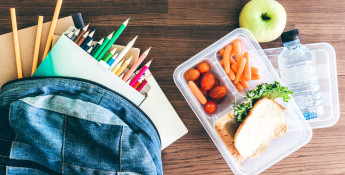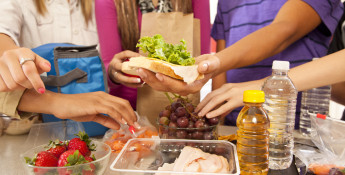By Cara Harbstreet on August 22, 2017
Less Stress Back-to-School Lunches

With children across the state heading back to school, the first few weeks can be wrought with emotion. Excitement, of course, but also stress, anxiety or worry about everything that needs to be done to help your students do their best.
I am an unapologetic supporter of school lunch - I spent time as an intern with school food service and learned to appreciate how much can be done with so little. With that said, I also unapologetically support families who choose to prepare meals at home. There is enough judgement around parenting that I refuse to add to it.
For the families who do send school lunches, it can be easy to turn to the convenience of a Lunchable or bags of highly processed, but nutritionally lacking foods. It’s quick, it’s easy and it usually keeps the kiddos happy. But we can’t neglect the importance of good nutrition in supporting students’ learning and developing through the school-aged years. Planning ahead is key, but what happens when you simply run out of ideas and resort to the same ‘ol things on repeat?
Here’s a few ideas (ok, more than a few) from dietitian Holly Grainer. She shared more than 100 examples of lunch box ideas that she uses for her family.
School Lunch Template
The template for a balanced school lunch matches with nutrition goals for any other meal. Ideally, it includes:
- Protein
- Grain or Starch
- Fruit
- Vegetable
- Dairy
Does this always happen? If you’re a parent you already know the answer to this, but no. And we can’t stress about that. If a food group is missing, focus on making up for it in other meals of the day. Add another serving of dairy at breakfast, use fruit as an after-school snack or use more veggies in your dinnertime meal. A single meal will not make or break a pattern of good nutrition, so a single day won’t represent any level of “failing.”
Dividing up Responsibilities
One of my favorite reminders to parents and caregivers is the Division of Responsibility. This term, coined by dietitian and family nutrition expert Ellyn Satter, is based on the concept that the parent and child each have unique responsibilities.
As the parent or caregiver, your duty is to decide what, when and where to eat (the when and where in this case are determined by the school). The child’s responsibility is to decide if they will eat the food and how much.
Parents can fulfill their responsibilities by providing the packed lunch, but that’s not to say children can’t have input or feedback about what’s included. Part of avoiding stress with lunchtime is making things practical AND peaceful. While we want meals to be nutritionally balanced as much as anyone else, it sometimes means we compromise on certain things. If it’s more practical to include a conveniently packaged version of a fruit, vegetable or whole grain, so be it. And if it causes fewer food fights to add a special treat or snack on occasion, that’s also fine.
Tried & True Tips
Here are some sage words of wisdom from other Kansas dietitians about how they approach school lunch:
Bethany Frazier, registered dietitian of The Kansas City Dietitian, says,“I think it's important to teach listening to hunger even if that means eating most of what would be considered the "less nutritious" parts of the meal. There is a lot of pressure to pack the perfect lunch, particularly as a dietitian, but when I pack my daughter's lunch I try to pack the things I think she'll most likely eat. But I also pack a carrot or a small piece of cantaloupe knowing that she probably won't eat it, but that with other kids around her and a different adult present, maybe she will try it.”
Kansas City-based dietitian Megan Harper suggests a similar strategy for all meals, lunch included. She advises families to have a balance of carbs, protein and fat to help balance blood sugar, give energy, enhance brain power and provide a feeling of fullness.
Her favorite simple lunch ideas: kabobs with cheese cubes, tomatoes and lunch meat with a side of crackers and fruit or veggies plus hummus and a sandwich with lunch meat and full fat cheese with a side of fruit. She also likes to spice up sandwiches by replacing mayo with mashed avocado.
Another dietitian in Kansas, Marcy Kohan Sedwick, credits the proper containers with keeping items appetizing for kids. She sources hers from Tupperware but adding more food storage containers can add up for your budget.





